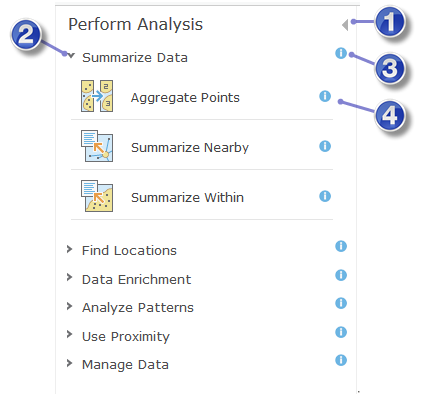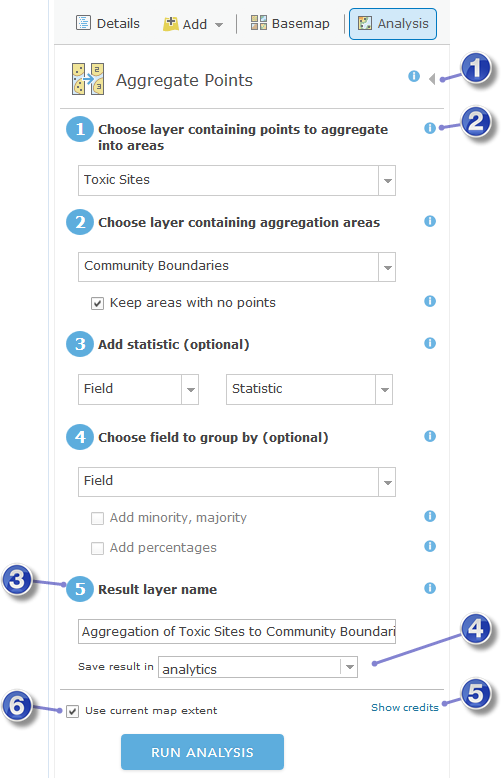Below you'll find information about accessing and using the analysis tools. This information applies to all tools.
License:
The administrator of your organization needs to grant you certain privileges for you to perform analysis. To use any of the analysis tools, you need the following privileges:
- Create, update, and delete content
- Publish hosted features
- Spatial Analysis
If you don't have these privileges, you will not see the Perform Analysis option as described below.
Certain tools need additional privileges such as Network Analysis and GeoEnrichment. See Perform analysis for more information about these tools.
Access the tools
To access and use analysis tools, follow these steps:
- Open a map containing the feature layer or layers you want to analyze in the map viewer.
- Click the Contents button in the Details pane.
- You can do one of the following:
- Click the Analysis button
 found on the map menu bar.
found on the map menu bar. - Alternatively, hover over the layer you want to analyze and click the Analysis button
 .
.
- Click the Analysis button
Both actions open the Perform Analysis pane.
Explore the Perform Analysis pane
The Perform Analysis pane is illustrated below. This pane contains a number of categories and each category contains tools. To view the tools within a category, click the expand/collapse button on the left side of the category.

 | Return to the Details pane. |
 | Expand the category to view tools within. |
 | View help about the category. |
 | View help for the tool. |
Work with a tool pane
To open an analysis tool pane, click the tool icon. This opens the tool's pane as illustrated below with the Aggregate Points tool.
Note:
Some tools only work on certain kinds of feature types; for example, Aggregate Points requires an input layer containing point features. This matters when you open the Perform Analysis pane by clicking the Analysis button  from under the layer—the tool will use that layer as its input. For example, if you click the Analysis button on a layer containing line or area features, choose Aggregate Points, the pane will not open—instead, it will display a message box You need to select a point feature layer to run Aggregate Points. You will need to return to the Details pane and choose another layer or click the Analysis button
from under the layer—the tool will use that layer as its input. For example, if you click the Analysis button on a layer containing line or area features, choose Aggregate Points, the pane will not open—instead, it will display a message box You need to select a point feature layer to run Aggregate Points. You will need to return to the Details pane and choose another layer or click the Analysis button  found on the map menu bar.
found on the map menu bar.

 | Close the tool pane without running the analysis and return to the Perform Analysis pane. |
 | Get help about a parameter. |
 | The result of running the analysis is saved to My Content using this name. |
 | You can specify a folder in My Content in which to save the result. |
 | Shows how many credits will be used if you run the analysis. |
 | If checked, only the data visible in the current map will be analyzed. |
Each tool has a different set of parameters. You can always view help for a parameter by clicking the help icon next to the parameter as illustrated above. All tools have a Result layer name parameter where the results of running the analysis are written. You can change this name or use the default value.
Use current map extent
Note:
It is recommended that you always check Use current map extent and that you zoom in to the area you want analyzed. Doing so limits the number of features the tool needs to examine when performing analysis. It also limits the number of credits that may be used by the tool if it is configured to use utility services from ArcGIS Online. If you uncheck Use current map extent, all features in the analysis layer will potentially be analyzed, and credits used by the tool will be based on the number of features in the layer.
Layers and data you can analyze
You can perform analysis on the following types of layers and data:
- Feature
service
The portal must be able to access the feature service; therefore, the URL to the service must either be publically accessible or within the same network as the portal and hosting server you use to run the anlaysis. You cannot perform analysis on layers based on nonaccessible feature services.
- Map service
As with feature services, the map service must be publically accessible or within the same network as the analyzing portal and hosting server.
- Hosted feature layers
- Hosted tile layers
The layer must have the query capability enabled.
- Comma-separated values (CSV) file (.csv)
- KML layers
- GPS exchange format file (.gpx)
- Shapefile (.zip)
- GeoRSS web feed
- Map notes
- Route layers
Analysis output
Most analysis tools run in the map viewer create hosted feature layers as output. These output layers are projected in the spatial reference of the input layer.